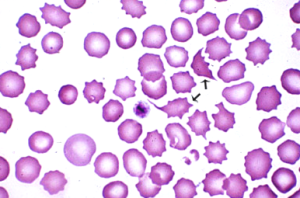What is Hemolytic uremic syndrome ?
Hemolytic uremic syndrome is a disorder that is caused due to anomalous and premature damage of red blood cells. The commencement of this process leads to the passage of large numbers of destroyed red blood cells to the kidneys, which eventually causes its filtering system to become blocked. This may then result in life threatening cases of kidney failure that is associated with hemolytic uremic syndrome.
A majority of hemolytic uremic syndrome cases develop after many days of diarrhea, usually bloody, in children. The diarrhea is mainly caused due to infection with a particular strain of the E. coli bacteria. Adults may also get affected by hemolytic uremic syndrome post infection by the bacteria. However, the cause generally tends to be vague or not known.
Hemolytic uremic syndrome is considered as a serious condition. However, early diagnosis and treatment generally results in a full recovery in patients, particularly in young children.

Symptoms of hemolytic uremic syndrome
Some of the signs and symptoms of hemolytic uremic syndrome are listed below:
- Bloody diarrhea
- Pain in the abdominal area
- Presence of blood in the urine or diminished urination
- Vomiting
- The skin tone may be pale
- Presence of low grade fever
- Increased irritability
- Fatigue
- Presence of inexplicable, tiny bruises
- Bleeding from the mouth and nose
- Confusion
- The hands, face, feet or the complete body may become swollen
- In rare cases, there may be occurrence of neurological signs such as seizures
A number of life threatening health complications may be caused due to hemolytic uremic syndrome. They include:
- Sudden, acute failure of the kidneys
- Chronic failure of the kidneys
- High blood pressure
- Stroke
- Cardiac problems
- Coma
Causes of hemolytic uremic syndrome
Hemolytic uremic syndrome may be caused due to many different reasons. However, the primary cause of the condition, especially in children, is infection with a particular strain of E. coli bacteria which is generally referred to as O157:H7
A group of bacteria that can be usually seen in the intestines of healthy animals and humans is known as E. coli. There are hundreds of different types of E. coli bacteria and most are safe. However, certain strains of the E. coli bacteria cause severe food borne conditions and one of these harmful varieties is responsible for causing hemolytic uremic syndrome.
E. coli may be present in lakes or swimming pools that are contaminated with feces, and in contaminated produce or meat.
It is important to note that a majority of the individuals infected with even the most harmful strains of E. coli bacteria may not develop symptom of hemolytic uremic syndrome. Also, hemolytic uremic syndrome may also develop after infection with a strain of the E. coli bacteria, which is different from the known strain.
The cause of hemolytic uremic syndrome in adults is usually not known. However, some of the known factors that cause the condition are as follows:
- Pregnancy
- The use of certain drugs such as cyclosporine (an immunosuppressant medication), the muscle cramp relaxant quinine, oral contraceptives and anti-platelet drugs
- Infection with the pneumococcal bacteria or the presence of some other infections such as HIV/AIDS
Individuals with the below mentioned risk factors are at a greater risk to developing hemolytic uremic syndrome than others:
- Individuals with an impaired or compromised immune system
- Children who are younger than five years old
- The presence of certain genetic abnormalities in some people that make them more vulnerable
- Adults above the age of sixty years
Treatment of hemolytic uremic syndrome
Replacement of fluids: Since the kidneys are functioning abnormally and not efficiently removing wastes and fluids, the lost electrolytes and fluids have to be replaced with care
- Transfusion of platelets: in case the person affected by hemolytic uremic syndrome is prone to easy bruising or bleeding, then platelet transfusions can aid the process of blood clotting. It is done via an intravenous needle
- Exchange of plasma: Plasma refers to that part of blood that aids the movement of platelets and blood cells. A medical instrument is sometimes used to remove the plasma from the blood and then replace it with frozen donor plasma.
- Transfusion of red blood cells: The lack of red blood cells in patients with hemolytic uremic syndrome may result in various symptoms such as yellowish skin, fatigue, chills, dark urine, shortness of breath and palpitations. Transfusion of red blood cell via an IV needle may assist in reducing and reversing these symptoms.
- Dialysis of the kidneys: A kidney dialysis may sometimes be needed to clear out the excess fluids and waste from the blood. It is a temporary solution which is stopped once the kidneys return to full functionality. A serious damage of the kidneys which results in kidney failure may however require permanent kidney dialysis or a kidney transplant
Even though hemolytic uremic syndrome is a very serious and life threatening condition, early detection and proper treatment can lead to a full recovery of the patients, particularly in young children.